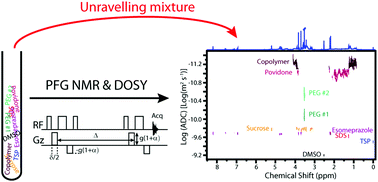Our official English website, www.x-mol.net, welcomes your feedback! (Note: you will need to create a separate account there.)
Pulsed-field gradient nuclear magnetic resonance measurements (PFG NMR) for diffusion ordered spectroscopy (DOSY) mapping
Analyst ( IF 4.2 ) Pub Date : 2017-08-14 00:00:00 , DOI: 10.1039/c7an01031a G. Pagès 1, 2, 3, 4 , V. Gilard 5, 6, 7, 8, 9 , R. Martino 5, 6, 7, 8, 9 , M. Malet-Martino 5, 6, 7, 8, 9
Analyst ( IF 4.2 ) Pub Date : 2017-08-14 00:00:00 , DOI: 10.1039/c7an01031a G. Pagès 1, 2, 3, 4 , V. Gilard 5, 6, 7, 8, 9 , R. Martino 5, 6, 7, 8, 9 , M. Malet-Martino 5, 6, 7, 8, 9
Affiliation

|
While NMR is the most used analytical method for determining the molecular structure of isolated chemical entities, small compounds as well as macromolecules, its capability of analysing complex mixtures is less known. The advent of Diffusion Ordered SpectroscopY (DOSY) NMR has made diffusion experiments popular, enabling diffusion coefficients to be routinely measured and used to characterize chemical systems in solution. Indeed, since the translational diffusion coefficients of molecular species reflect their effective sizes and shapes, DOSY NMR allows the separation of the chemical entities present in multicomponent systems and, as in all diffusion NMR experiments, provides information on their intermolecular interactions as well as on their size and shape. The main aim of this review is to present an overview of the DOSY NMR mapping and its applications. The paper starts with a brief introduction to pulsed-field gradient (PFG) NMR and then focuses on the methodological procedures that can be used to perform good diffusion data acquisition and to obtain good-quality DOSY maps. The second part describes, through selected literature examples, different applications of DOSY NMR to demonstrate the potential of the method for (i) unravelling the components of complex matrices comprising pharmaceuticals, dietary supplements, foods and beverages, and biological extracts, and (ii) probing intermolecular interactions and evaluating association constants between different hosts and guests, as well as estimating the sizes and molecular weights of molecular species.
中文翻译:

用于扩散有序光谱(DOSY)映射的脉冲场梯度核磁共振测量(PFG NMR)
尽管NMR是确定分离的化学实体,小分子化合物和大分子的分子结构最常用的分析方法,但其分析复杂混合物的能力却鲜为人知。扩散有序光谱学(DOSY)NMR的出现使得扩散实验变得很流行,这使得能够常规测量扩散系数并用于表征溶液中的化学体系。实际上,由于分子种类的平移扩散系数反映了它们的有效大小和形状,DOSY NMR可以分离多组分系统中存在的化学实体,并且像所有扩散NMR实验一样,它提供有关其分子间相互作用以及它们之间相互作用的信息。尺寸和形状。本文的主要目的是概述DOSY NMR谱图及其应用。本文首先简要介绍了脉冲场梯度(PFG)NMR,然后重点介绍了可用于执行良好扩散数据采集并获得高质量DOSY图的方法程序。第二部分通过选定的文献实例描述了DOSY NMR的不同应用,以证明该方法的潜力(i)揭示包括药物,膳食补充剂,食品和饮料以及生物提取物的复杂基质的成分,以及(ii)研究分子间的相互作用并评估不同宿主与客体之间的缔合常数,以及估计分子种类的大小和分子量。本文首先简要介绍了脉冲场梯度(PFG)NMR,然后重点介绍了可用于执行良好扩散数据采集并获得高质量DOSY图的方法程序。第二部分通过选定的文献实例描述了DOSY NMR的不同应用,以证明该方法的潜力(i)揭示包括药物,膳食补充剂,食品和饮料以及生物提取物的复杂基质的成分,以及(ii)研究分子间的相互作用并评估不同宿主与客体之间的缔合常数,以及估计分子种类的大小和分子量。本文首先简要介绍了脉冲场梯度(PFG)NMR,然后重点介绍了可用于执行良好扩散数据采集并获得高质量DOSY图的方法程序。第二部分通过选定的文献实例描述了DOSY NMR的不同应用,以证明该方法的潜力(i)揭示包括药物,膳食补充剂,食品和饮料以及生物提取物的复杂基质的成分,以及(ii)研究分子间的相互作用并评估不同宿主与客体之间的缔合常数,以及估计分子种类的大小和分子量。
更新日期:2017-08-31
中文翻译:

用于扩散有序光谱(DOSY)映射的脉冲场梯度核磁共振测量(PFG NMR)
尽管NMR是确定分离的化学实体,小分子化合物和大分子的分子结构最常用的分析方法,但其分析复杂混合物的能力却鲜为人知。扩散有序光谱学(DOSY)NMR的出现使得扩散实验变得很流行,这使得能够常规测量扩散系数并用于表征溶液中的化学体系。实际上,由于分子种类的平移扩散系数反映了它们的有效大小和形状,DOSY NMR可以分离多组分系统中存在的化学实体,并且像所有扩散NMR实验一样,它提供有关其分子间相互作用以及它们之间相互作用的信息。尺寸和形状。本文的主要目的是概述DOSY NMR谱图及其应用。本文首先简要介绍了脉冲场梯度(PFG)NMR,然后重点介绍了可用于执行良好扩散数据采集并获得高质量DOSY图的方法程序。第二部分通过选定的文献实例描述了DOSY NMR的不同应用,以证明该方法的潜力(i)揭示包括药物,膳食补充剂,食品和饮料以及生物提取物的复杂基质的成分,以及(ii)研究分子间的相互作用并评估不同宿主与客体之间的缔合常数,以及估计分子种类的大小和分子量。本文首先简要介绍了脉冲场梯度(PFG)NMR,然后重点介绍了可用于执行良好扩散数据采集并获得高质量DOSY图的方法程序。第二部分通过选定的文献实例描述了DOSY NMR的不同应用,以证明该方法的潜力(i)揭示包括药物,膳食补充剂,食品和饮料以及生物提取物的复杂基质的成分,以及(ii)研究分子间的相互作用并评估不同宿主与客体之间的缔合常数,以及估计分子种类的大小和分子量。本文首先简要介绍了脉冲场梯度(PFG)NMR,然后重点介绍了可用于执行良好扩散数据采集并获得高质量DOSY图的方法程序。第二部分通过选定的文献实例描述了DOSY NMR的不同应用,以证明该方法的潜力(i)揭示包括药物,膳食补充剂,食品和饮料以及生物提取物的复杂基质的成分,以及(ii)研究分子间的相互作用并评估不同宿主与客体之间的缔合常数,以及估计分子种类的大小和分子量。



























 京公网安备 11010802027423号
京公网安备 11010802027423号